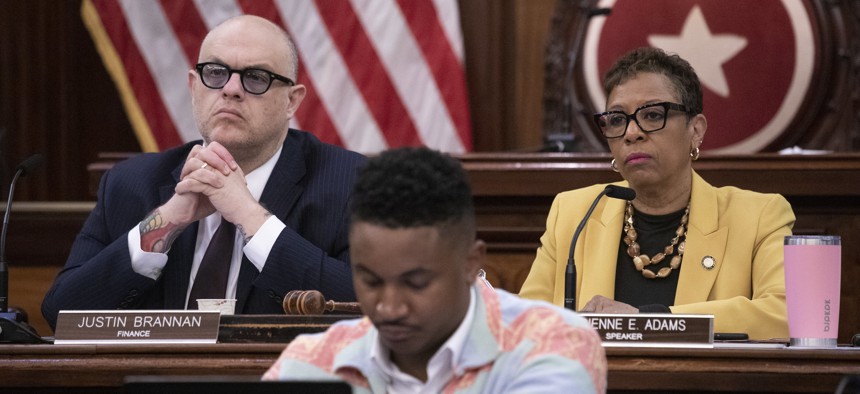Budget
As budget season gets underway, council presses administration for collaboration
City Comptroller Brad Lander accused the mayor of announcing deep budget cuts so that he could later magnanimously reverse them.

New York City Council Finance Chair Justin Brannan and Speaker Adrienne Adams listen to testimony during the council’s first preliminary budget hearing. John McCarten/NYC Council Media Unit
New York City’s annual budget dance is picking up its pace, as a City Council hearing on Mayor Eric Adams’ preliminary budget on Monday kicked off the months-long process to negotiate and adopt a final budget for the upcoming fiscal year.
But first, the City Council and the Adams administration have to get on the same page about exactly how much money there is to work with. The City Council released an updated forecast over the weekend that predicts an additional roughly $3.3 billion in tax revenues beyond what the mayor’s Office of Management and Budget had already predicted for the current fiscal year and upcoming fiscal year 2025. That more optimistic forecast is driven by higher than expected personal income, business, property and sales tax revenue, the council said.
The City Council and the administration are often not on the same page about how much money there is to work with at this point in the budget process, with the administration traditionally making more conservative revenue estimates than both the City Council and other reviewers, including the city’s Independent Budget Office.
Those discrepancies are particularly noticeable in a year like this, following several successive rounds of citywide budget cuts – known as “Programs to Eliminate the Gap,” or PEGs. In the last year, the Adams administration has blamed the spending cuts on its need to fund services for asylum-seekers.
In recent months, the Adams administration itself has slightly veered away from its doom-and-gloom predictions – offering a somewhat rosier fiscal outlook in January and backing away from another round of citywide cuts planned for April. Council leaders took a modest victory lap at Monday’s hearings, arguing again that the administration has been overzealous in cutting funding to agencies. “Bit by bit, the administration has indeed reversed course on both their PEGs and the (municipal) hiring freeze, and has updated their forecast of revenues to largely match the outlook the council had projected about three months ago, back when we were told that council economists were being too liberal with our forecast,” City Council Finance Committee Chair Justin Brannan said. “Since then, we've seen the economic outlook brighten even further.”
Monday’s Committee on Finance hearing is the first in a month-long series of preliminary budget hearings to be held by other council committees. That will be followed by the administration’s presentation of an executive budget proposal, another round of council hearings on that proposal and eventually the adoption of a final budget, which the administration and council must agree on by June 30.
The hearing proceeded largely as expected, with City Council members criticizing previous PEGs and questioning the wisdom of the administration continuing to hew to more conservative forecasts. “Is there not a concern that an overly conservative revenue estimate will lead to unnecessary service reductions?” Brannan asked at one point. New York City Budget Director Jacques Jiha, who bore the brunt of the council’s questioning on Monday, responded that the administration doesn’t have that concern, as it can’t afford to overestimate revenues.
In several exchanges, Council members lamented a lack of coordination from City Hall. When answering questions from Speaker Adrienne Adams about whether funding that had previously been cut would be restored, Jiha said that it’s hard to tell at this point. “If financial conditions improve and the economy remains strong, we will work with the council, as we always do, to look at the priorities of the council and the administration, and then see what can be fully or partially restored,” he said.
But Speaker Adams noted that priorities for budget cuts in previous rounds of PEGs were identified without the collaboration of the council. “You just said something very, very critical to me that caught my ear,” Speaker Adams said. “‘The priorities of the administration and the council.’ What happened to that interaction and that collaboration in these first rounds (of budget cuts)?”
In statements leading up to this hearing, council leaders have made it clear that they aim to fight for the restoration of funding previously cut, including for 3-K, library services and cultural institutions. The administration was noncommittal in their testimony on Monday about whether they would support those kinds of restorations, saying they could have those conversations closer to adoption. “We wish we could have restored a lot of things, but again, we’re dealing with a major financial crisis, and that requires a lot of resources,” Jiha said.
Testimony at Monday’s hearing stretched into the afternoon. In his testimony, city Comptroller Brad Lander noted that his office projects a $3.3 billion gap in the upcoming fiscal year budget. He also accused the Adams administration of having ulterior motives in making “wild swings” in estimates of its spending on services for asylum-seekers. “Given the timing of those announcements, it is quite reasonable for the council to believe that they were made for the purpose of establishing a rationale to order large PEGs from city agencies, and then reverse the worst of them in a show of magnanimity,” Lander said in his testimony.
And while City Council leaders agreed with the administration’s cancellation of a PEG planned for April, the fiscally conservative watchdog group Citizen Budget Commission argued against it in its testimony. “Even if higher revenue projections prove accurate, which would be good news, the city may abruptly face funding shortfalls that require significant, sudden spending cuts that can harm programs more than restraining spending to affordable levels over time,” Citizens Budget Commission Vice President for Research Ana Champeny said.

